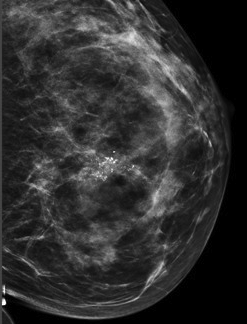 Breast calcifications are calcium deposits that develop within breast tissue. They are too small to be felt, but they are commonly found on mammograms, appearing as bright white spots. Calcifications are usually benign and are especially prevalent in postmenopausal women.[1] They can appear as the result of age, a past infection, injury, surgery, or breast implants.[2]
Breast calcifications are calcium deposits that develop within breast tissue. They are too small to be felt, but they are commonly found on mammograms, appearing as bright white spots. Calcifications are usually benign and are especially prevalent in postmenopausal women.[1] They can appear as the result of age, a past infection, injury, surgery, or breast implants.[2]
Breast Calcifications
Two types of calcifications may be found on a mammogram, macrocalcifications and microcalcifications. Macrocalcifications appear large and round on a mammogram any are typically spread throughout the breast tissue in a seemingly random pattern. Microcalcifications, on the other hand, are smaller and irregularly shaped.[3] Although both forms are usually benign, certain patterns of microcalcifications warrant further follow-up. Detection of these patterns may be the earliest sign of developing breast cancer.[4]
When calcifications are detected on a mammogram, the radiologist examines magnified views to get more information about their size, shape, and pattern of distribution. Based on this information, the calcifications are classified as benign, probably benign, indeterminate, or suspicious.

- Benign – These are of no concern and require no follow-up aside from continued annual screening mammograms.[5]
- Probably Benign – These calcifications are at least 97% likely tobe benign. However, a three-year follow-up program ensures that, in the unlikely event that they do represent cancer, it can be detected as early as possible. After six months, diagnostic images are taken of the breast in which calcifications appeared. After one year, and annually for another two years, the procedure is repeated with both breasts. Each time images are taken, the calcifications are magnified so the radiologist may inspect them closely to detect any changes. If no change is found during this time, they are considered stable, and no further diagnosis is needed. Regular annual screening is resumed.
- Indeterminate – If breast calcifications are classified as indeterminate, then the radiologist may recommend short-term follow-up and/or biopsy. [6]
- Suspicious – These types of calcifications present in shapes and patterns that suggest a higher probability of cancer.[7] A biopsy is necessary to assess the condition. Both indeterminate and suspicious calcifications can appear in either benign or malignant conditions,[8] and 80-90% of calcification biopsies return normal results.[9]
Iowa Radiology performs breast biopsy using a variety of methods, including ultrasound-guided, MRI- guided, and stereotactic (mammography with or without tomosynthesis guidance), in a comfortable and convenient outpatient setting. These procedures are non-surgical and minimally invasive. For more information about follow-up after mammography, read our blog post, "I Got a Callback After My Screening Mammogram. What Is the Next Step?"
Iowa Radiology strives to make our patients as comfortable as possible and to provide clear and complete answers to any questions they may have about their procedures. Contact us to schedule your next screening mammogram or to discuss any questions or concerns about your results.
Iowa Radiology is also a proud sponsor of the Pink Days program. If you do not have insurance to cover your mammogram, you may qualify for free annual screening.
For more updates to keep you healthy, subscribe to our blog.
[1] http://www.mayoclinic.org/symptoms/breast-calcifications/basics/definition/sym-20050834
[2] https://www.breastcancercare.org.uk/breast-cancer-information/benign-breast-conditions/breast-calcifications
[3] http://ww5.komen.org/uploadedfiles/content_binaries/806-03203a.pdf
[4] http://www.ncbi.nlm.nih.gov/pmc/articles/PMC2797739/
[5] http://www.webmd.com/women/guide/breast-calcification-symptoms-causes-treatments#1
[6] https://subrad.com/the-breast-center/breast-education/calcifications.
[7] Ibid.
[8] http://www.cancer.org/healthy/findcancerearly/examandtestdescriptions/mammogramsandotherbreastimagingprocedures/mammograms-and-other-breast-imaging-procedures-mammo-report
[9] https://subrad.com/the-breast-center/breast-education/calcifications
The information contained in the Iowa Radiology website is presented as public service information only. It is not intended to be nor is it a substitute for professional medical advice.You should always seek the advice of your physician or other qualified healthcare provider if you think you may have a medical problem before starting any new treatment, or if you have any questions regarding your medical condition.
Iowa Radiology occasionally supplies links to other web sites as a service to its readers and is not in any way responsible for information provided by other organizations.


